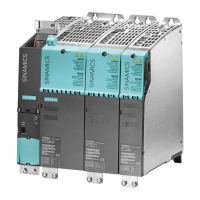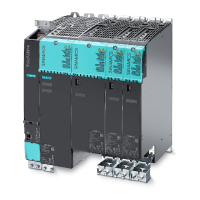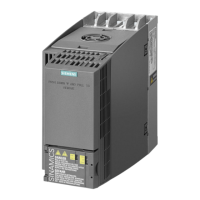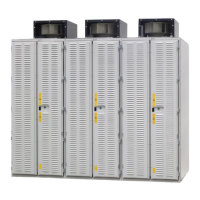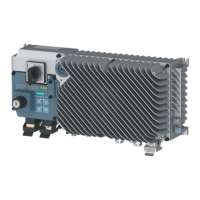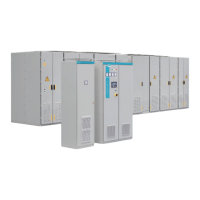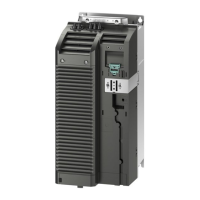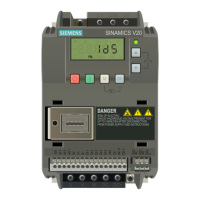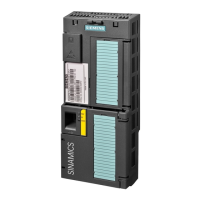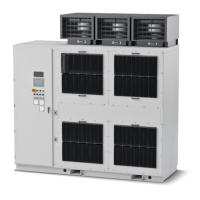Fundamental Principles and System Description
Engineering Information
SINAMICS Engineering Manual – November 2015
Ó Siemens AG
97/528
Both, the peak values and rms values increase in proportion to the line voltage or DC link voltage. Peak values are
not influenced by pulse frequency or cable length while rms values increase in proportion to pulse frequency and
cable length.
Since the above analysis does not take the grounding system inductance into account, the real values are generally
lower. If motor reactors or motor filters are installed, the leakage currents are reduced even further.
What proportion of the high-frequency leakage current I
Leak
carried by the motor cable shield reaches the line-side PE
connection depends on the line filters in the converter Chassis unit or converter cabinet, as described on the previous
page. The oscillograms shown in the previous page provide a rough guide as to the reduction in leakage currents at
the PE connection that can be achieved depending on the line filters used. Even when line filters in accordance with
category C2 are installed, leakage current peak values of > 1 A might occur at the PE connection with the largest
units in Booksize format and of 10 A with the largest units in Chassis format.
As the analysis above makes clear, high-frequency leakage currents at the line-side PE connection are not negligible,
even when relatively extensive RFI suppression measures are implemented. For this reason, it is not generally
possible to use line-side residual-current circuit breakers (RCCBs) or universal-AC/DC-sensitive residual current
monitors on SINAMICS drives in the power range of the converters described in this engineering manual. This
applies to both, RCCBs with an operating threshold of 30 mA for personnel protection as well as to RCCBs with an
operating threshold of 300 mA for fire protection. Experience indicates that only drives with short motor cable lengths
of < 10 m and and power ratings up to about 0.5 kW can operate satisfactorily on 30 mA RCCBs. The same applies
to drives with short motor cable lengths of < 10 m and power ratings up to about 5 kW on 300 mA RCCBs. For further
information, please refer to the "Guideline for Residual-Current Circuit Breakers and Electric Drives" (Leitfaden für
Fehlerstrom-Schutzeinrichtungen und elektrische Antriebe) published by the ZVEI (German Electrical and Electronic
Manufacturers' Association).
1.5.3.5 EMC-compliant installation
To ensure that the line filters can achieve the intended filtering effect, it is essential to install the entire drive system
correctly. The installation must be such that interference current can find a continuous, low-inductance path without
interruptions or weak points from the shield of the motor cable to the PE or EMC shield busbar and the line filter back
to the inverter.
Compliance with categories C2 and C3 of EMC product standard EN 61800-3 therefore requires a shielded cable for
the connection between converter and motor. For higher outputs in the SINAMICS Chassis and cabinet unit power
range, a symmetrical 3-wire, three-phase cable should be used to make the connection whenever possible.
Shielded cables with symmetrically arranged three-phase conductors L1, L2 and L3 and an integrated, 3-wire,
symmetrically arranged PE conductor, such as the PROTOFLEX EMV-FC, type 2XSLCY-J 0.6/1 kV illustrated below
which is supplied by Prysmian, are ideal.
Shielded, symmetrically arranged three-phase cable with 3-wire PE conductor
Alternatively, it is also possible to use a shielded cable containing only three-phase conductors L1, L2 and L3 in a
symmetrical arrangement, for example, 3-wire cables of type Protodur NYCWY. In this case, the PE conductor must
be routed separately as close as possible and in parallel to the 3-wire motor cable.
For outputs in the Booksize and Blocksize unit power range, and for lower outputs in the Chassis and cabinet unit
power range, it is also possible to use shielded, asymmetrical, 4-wire cables (L1, L2, L3 plus PE) such as power
cables of type MOTION-CONNECT.
L1
L2 L3
PE PE
PE
L1
L2 L3
PE
PE
L1L2
L3
ideal symmetrical 3-wire cable plus
symmetrically arranged PE conductor
symmetrical 3-wire cable with
separately routed PE conductor
asymmetrical 4-wire cable
including the PE conductor
Shielded three-phase cables with concentric shield
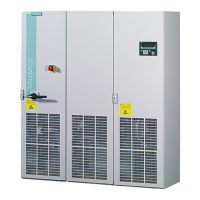
